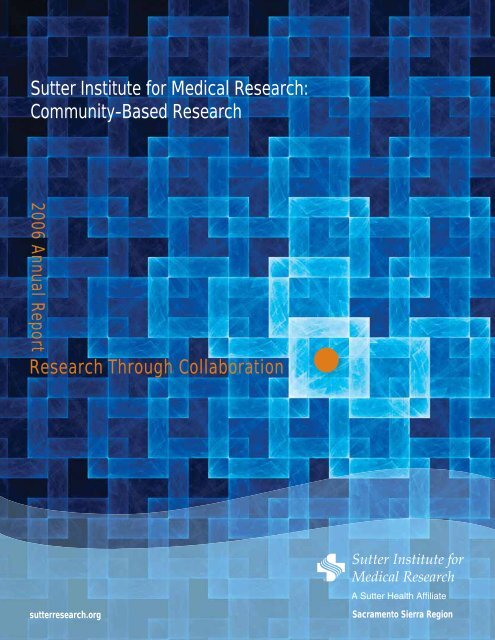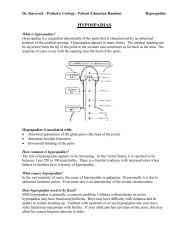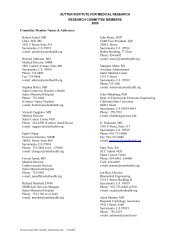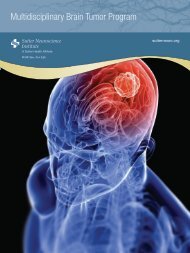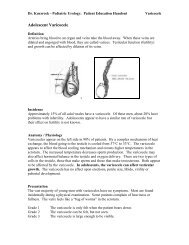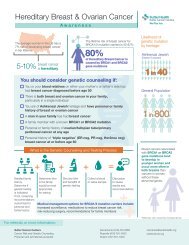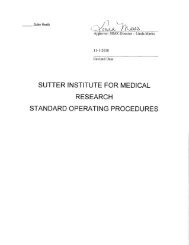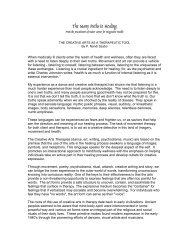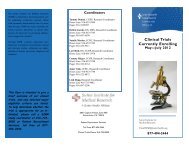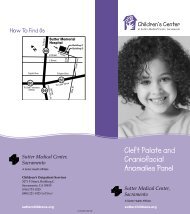Community-Based Research - Sutter Health Sacramento Sierra ...
Community-Based Research - Sutter Health Sacramento Sierra ...
Community-Based Research - Sutter Health Sacramento Sierra ...
You also want an ePaper? Increase the reach of your titles
YUMPU automatically turns print PDFs into web optimized ePapers that Google loves.
<strong>Sutter</strong> Institute for Medical <strong>Research</strong>:<br />
<strong>Community</strong>-<strong>Based</strong> <strong>Research</strong><br />
2006 Annual Report<br />
<strong>Research</strong> Through Collaboration<br />
sutterresearch.org<br />
<strong>Sacramento</strong> <strong>Sierra</strong> Region<br />
R1.SIMR_AR06.indd 1<br />
9/18/07 1:11:20 PM
<strong>Sutter</strong> Institute for Medical <strong>Research</strong> (SIMR)<br />
provides a stable framework linking medical research<br />
with patient care. Through SIMR, <strong>Sutter</strong>-affiliated<br />
physicians receive the administrative support and<br />
safety oversight needed to conduct prudent, successful<br />
research. SIMR was founded in 1959 at <strong>Sacramento</strong>’s<br />
<strong>Sutter</strong> Memorial Hospital and now offers research<br />
opportunities throughout the <strong>Sutter</strong> <strong>Health</strong> <strong>Sacramento</strong><br />
<strong>Sierra</strong> Region’s five acute-care hospitals, many<br />
outpatient facilities and hundreds of primary-care and<br />
specialty physicians.<br />
R1.SIMR_AR06.indd 2<br />
9/18/07 1:11:44 PM
<strong>Sutter</strong> Institute for Medical <strong>Research</strong> (SIMR)<br />
Every new drug or medical device results from the<br />
combined effort of hundreds or even thousands of<br />
dedicated individuals. From research professionals to<br />
volunteer participants, each plays a critical role in<br />
moving medical science forward.<br />
At <strong>Sutter</strong> Institute for Medical <strong>Research</strong>, we support<br />
that advancement through a unique model that brings<br />
medical research to the community level, enabling<br />
physicians in private practice to offer their patients<br />
access to recent developments. Even at this level,<br />
safe, successful clinical research requires dozens<br />
of individuals—physician investigators, research<br />
coordinators, finance and administrative professionals,<br />
and safety oversight experts.<br />
Perhaps most important, it takes the selfless<br />
commitment of patients willing to serve as volunteer<br />
participants. It is to that spirit of collaboration within<br />
our local community and the commitment to serve the<br />
greater good beyond it that we dedicate this report.<br />
Our Mission<br />
To integrate<br />
research into<br />
clinical care.<br />
R1.SIMR_AR06.indd 3<br />
9/18/07 1:11:50 PM
From the Medical Director<br />
John Mesic, M.D., CMO of <strong>Sutter</strong> <strong>Health</strong> <strong>Sacramento</strong><br />
<strong>Sierra</strong> Region, Linda Marks, Director of SIMR<br />
Operations, Andrew Hudnut, M.D., SIMR Medical<br />
Director<br />
In the ever-changing medical research world, we are<br />
seeing an encouraging shift toward greater openness<br />
and collaboration.<br />
In this report, you’ll read about doctors whose desires to<br />
improve patient care took them beyond traditional research<br />
boundaries. These stories exemplify the collaborative spirit we<br />
are cultivating at SIMR and illustrate our mission of integrating<br />
research into patient care.<br />
By supplying the administrative support to bring research<br />
into real-life patient care, SIMR provides fertile ground for<br />
cooperative efforts. In 2006, we strengthened that support<br />
while moving outside SIMR’s own borders to connect with<br />
others who share our goals.<br />
Internally, we continued strengthening the highly capable<br />
research coordinator group at SIMR’s epicenter. Under Director<br />
of <strong>Research</strong> Operations Linda Marks’ leadership, SIMR has a<br />
solid team skilled at both managing administrative details and<br />
building rapport with trial volunteers. Also under Linda’s able<br />
guidance, SIMR staff streamlined the processes for managing<br />
complex contract and accounting requirements. With so many<br />
variables to track with each study and every investigator, I<br />
cannot overstate the enormity of this accomplishment.<br />
We also made exciting progress in refi ning volunteer<br />
recruitment into a HIPAA-compliant routine that combines<br />
database research with a call center system for contacting<br />
doctor-approved patients. The call center also handles<br />
incoming calls from recruitment advertising for SIMR’s local<br />
trials and under contract with sponsors for national advertising<br />
campaigns. While doctors personally talking with patients<br />
remains the most successful recruitment method, the call<br />
center offers an effective proactive alternative.<br />
We continued our geographic outreach this year with<br />
several studies conducted at more than one site and across<br />
multiple specialties and medical practices. In 2006, we began<br />
laying the groundwork for a dedicated research team in <strong>Sutter</strong>’s<br />
Solano County medical offi ces. Enthusiastic interest from<br />
doctors in several specialties and whole-hearted administrative<br />
support has resulted in a part-time research coordinator on site<br />
at that location.<br />
We are also experiencing a different type of expansion<br />
through cross-pollination with other research groups. Close<br />
to home, we are working with academic researchers at two<br />
universities to create a more inclusive local research network.<br />
Regionally, we are establishing an exciting connection with<br />
research affi liates within the <strong>Sutter</strong> family. In the coming<br />
year, each <strong>Sutter</strong> research affi liate will install a clinical<br />
research information system used by many leading research<br />
organizations. Implementing this software allows us to<br />
coordinate clinical trials sites across the larger <strong>Sutter</strong> region,<br />
opening up tremendous collaborative possibilities.<br />
On a national level, the National Council of University<br />
Administrators (NCURA) asked Linda Marks to be part of an<br />
annual meeting panel discussing the ideal research offi ce.<br />
Panel members represent different research models, with Linda<br />
representing research within a community hospital setting. The<br />
invitation spotlights SIMR’s uncommon approach and offers an<br />
opportunity to expand our relationships.<br />
In closing, I want to thank the SIMR team for their<br />
exceptional work establishing the well-functioning systems<br />
we now have in place. Thank you as well to the dedicated<br />
investigators we are so fortunate to have working with SIMR.<br />
The future holds great promise for us all—and for patients<br />
everywhere.<br />
Sincerely,<br />
Andrew Hudnut, M.D.<br />
Medical Director<br />
R1.SIMR_AR06.indd 4<br />
9/18/07 1:11:59 PM
2006 Clinical Trials<br />
During 2006, <strong>Sutter</strong> Institute for Medical <strong>Research</strong> has participated<br />
in a number of research study initiatives in a wide range of disease<br />
areas. The following is a list of service areas and a few of the research<br />
studies activated for the 2006 year:<br />
Cardiology<br />
• A Double-Blind, Randomized, Placebo-Controlled Study<br />
of the Effects of Study Drug on Heart Failure Signs and<br />
Symptoms and Renal Function of Patients with Acute<br />
Heart Failure Syndrome and Renal Impairment Who are<br />
Hospitalized for Volume Overload and Require IV Diuretic<br />
Therapy.<br />
• Follow-up Serial Infusions or Study Drug for Management<br />
of Patients with Heart Failure.<br />
• A Multi-center Randomized, Double-Blind, Double-<br />
Placebo, Parallel Group Study to Compare the Effects<br />
of Slow-Release Beta-Blockers (once-a-day vs. twice-aday)<br />
on Ejection Fraction in Patient with Stable Chronic<br />
Heart Failure.<br />
Family Practice/Internal Medicine<br />
• A Twelve-Week, Randomized, Double-Blind, Dose-<br />
Ranging, Placebo-Controlled Study of Study Drug in<br />
Patient with Irritable Bowel Syndrome.<br />
• A Thirty-Six-Week Randomized, Double-Blind, Parallel-<br />
Group Active-Controlled Comparative Drug Study for<br />
Patient > 65 Years Old with Systolic Essential Hypertension.<br />
Neurology<br />
• A Fifty-Four-Week, Double-Blind, Randomized, Placebo<br />
Controlled, Parallel-Group Study to Investigate the<br />
Effects of Study Regimens on Cognition and Overall<br />
Clinical Response in APOE 4-Stratefi ed Patients with Mild<br />
to Moderate Alzheimer’s Disease.<br />
• Interventional Management of Strokes Study.<br />
Orthopedics<br />
• A Prospective, Randomized Controlled Study Comparing<br />
Cervical Disc Replacement and Fusion for the Treatment<br />
of Cervical Degenerative Disc Disease.<br />
• In Vivo Assessment of Hip Kinematics during Four<br />
Activities.<br />
• CT Validation of a Computer Aided Surgery for Total Hip<br />
Replacement.<br />
Oncology<br />
• A Phase 3 Randomized, Open-Label Comparison Study<br />
for Androgen-Independent Prostate Cancer.<br />
• A Phase III Randomized, Double-Blinded, Multi-Center<br />
Study to Assess the Effects of Study Combination Study<br />
Regimens in Patients with Locally Advanced Metastatic<br />
(Stage IIIb-IV) Non-Small Cell Lung Cancer (NSCLC)<br />
After Failure of First-Line Anti-Cancer Therapy.<br />
• A Phase I/II Open-Label, Single-Blind, Multi-center,<br />
Single-Dose, Dose-Escalating Safety and Tolerability<br />
Study of Intrathecal Study Drug on Oncology Patients.<br />
Pediatric Oncology<br />
• A Phase II Study of Concurrent Radiation and Study<br />
Regimens in Treatment of High-Grade Gliomas.<br />
• A Phase III Study for the Treatment of Children and<br />
Adolescents with Newly Diagnosed Low-Risk Hodgkin’s<br />
Disease.<br />
• Treatment of Late Isolated Extramedullary Relapse from<br />
Acute Lymphoblastic Leukemia (ALL).<br />
Others<br />
• A Multi-Center, Randomized, Double-Blind Study of the<br />
Clinical Outcomes, Safety and Tolerability of Study Drug<br />
in Children Ages 1 to 5, with Endoscopically Proven<br />
GERD.<br />
• A Randomized Open-Label, Parallel Arm Study to<br />
Investigate the Role of Excipients in the Evaluation of<br />
Study Therapy in Diabetes Type 2 Patients’ Changes in<br />
Lung Functions.<br />
2006 Physician-Initiated <strong>Research</strong> Studies<br />
<strong>Sutter</strong> physicians throughout the region initiate a number<br />
of research trials. For a detailed list please visit<br />
http://www.suttermedicalcenter.org/library/.<br />
R1.SIMR_AR06.indd 5<br />
9/18/07 1:12:02 PM
Physician-Initiated <strong>Research</strong> Studies<br />
When doctors’ professional curiosity or empirical observations inspire<br />
them to pursue those inquiries, SIMR offers research funding and<br />
professional assistance. <strong>Research</strong> Scientist Carol Parise, Ph.D., heads<br />
up research support services and works with doctors to design studies<br />
that deliver statistically meaningful results and to help them analyze<br />
those results.<br />
Impact of Computers in the Exam Room<br />
As a faculty member of <strong>Sutter</strong>’s Family Medicine<br />
Residency Program, family practice physician Marion Leff,<br />
M.D., was interested in understanding how patients felt<br />
about computers in the exam room. <strong>Sutter</strong> had recently<br />
undergone the transition to electronic medical records<br />
and doctors had strong opinions on how the computers<br />
would affect care. By objectively studying the subject,<br />
Dr. Leff hoped to determine the specifi c issues doctors<br />
needed to address.<br />
The study involved adding three questions to the<br />
Standard Daily Patient Visit questionnaire to determine<br />
patients’ opinions on their quality of care before, during<br />
and after computers were introduced. “I had my own<br />
preconceived notion that patients would hate the<br />
computers,” admitted Dr. Leff, “but our results showed<br />
they didn’t make a difference in the patient/physician<br />
relationship and that patients felt computers and<br />
electronic medical records improved their quality of<br />
care.” Dr. Leff presented the results in a poster to the<br />
Association of Family Medicine Residency Directors in<br />
May and received second place award in its category for<br />
“quality-improvement studies.”<br />
<strong>Research</strong> Team: Marion Leff, M.D., Family Medicine<br />
Physician and Faculty Member of <strong>Sutter</strong>’s Family<br />
Practice Residency Program, Carol Parise, SIMR<br />
<strong>Research</strong> Scientist, Bobbie Benabides, SIMR <strong>Research</strong><br />
Data Technician<br />
R1.SIMR_AR06.indd 6<br />
9/18/07 1:12:04 PM
Long-Term <strong>Health</strong> Effects<br />
of Eating Disorders<br />
Internal medicine and clinical nutrition specialist Ann Gerhardt, M.D.,<br />
has had the unique experience of helping patients during eating disorder<br />
treatment and working with those patients years after recovery. Her<br />
experience with two patients in particular led to her observation that<br />
some eating disorder patients suffered long-term effects doctors had not<br />
connected to the earlier eating disorder. To determine if what she saw<br />
could be proven statistically, Gerhardt received a <strong>Sutter</strong> research grant to<br />
locate and question eating disorder patients treated many years earlier.<br />
<strong>Research</strong>er: Ann Gerhardt, M.D., Internal<br />
Medicine Physician and Hospitalist<br />
“Eating disorders fall under psychiatric diagnosis and<br />
treatment,” said Gerhardt. “Physical care involves keeping<br />
patients healthy enough to recover from the psychiatric<br />
disorder, so little attention has been given to the physical<br />
consequences that may appear many years later.”<br />
Gerhardt’s study asks patients who once underwent<br />
eating disorder treatment to complete a detailed<br />
questionnaire about their current physical health. The<br />
study aims to establish if an association exists between<br />
eating disorder and later health challenges. To date, the<br />
study that began in 2005 has only reached 39 of the 50<br />
patients needed to deliver a statistically meaningful result.<br />
According to Gerhardt the low numbers are no surprise,<br />
“Unfortunately, the very nature of eating disorders makes<br />
the study challenging,” said Gerhardt. “Even when former<br />
patients can be located, they are often reluctant to talk<br />
about the disorder. They either want to put that chapter<br />
behind them or they continue to suffer privately from the<br />
disorder.”<br />
Gerhardt is continuing to look for patients over 30 who have<br />
or have had eating disorders, adding, “These few patients<br />
may help us uncover connections that could help millions of<br />
people.”<br />
R1.SIMR_AR06.indd 7<br />
9/18/07 1:12:07 PM
Clinical Trial<br />
Irritable Bowel Syndrome<br />
<strong>Sacramento</strong> <strong>Research</strong> Team: Abdul Khaleq, M.D.,<br />
Gastroenterologist, and Janet Duvall, SIMR Clinical<br />
Trials <strong>Research</strong> Coordinator<br />
offer patients care that otherwise would not be available.<br />
It’s also SIMR’s fi rst clinical trial involving both primary and<br />
specialty care doctors.”<br />
Elk Grove <strong>Research</strong> Team: Dan Fields, M.D., Family<br />
Medicine, Mary Hyland, SIMR Clinical Trials <strong>Research</strong><br />
Coordinator, Andrew Hudnut, SIMR Medial Director and<br />
Family Medicine Physician<br />
Certain health conditions continue to elude medicine’s<br />
best efforts, causing doctors and patients alike to look<br />
beyond current, often disappointing, treatment options.<br />
Irritable bowel syndrome (IBS) is one such condition.<br />
“IBS patients are often in pain, yet many fi nd no relief<br />
from the two medications currently FDA approved for<br />
treatment,” said <strong>Sacramento</strong> gastroenterologist Abdul<br />
Khaleq, M.D. When given the chance to participate in<br />
a Phase III clinical trial for a drug that treats abdominal<br />
discomfort often associated with IBS, Dr. Khaleq was<br />
immediately interested.<br />
Across town, Elk Grove family medicine doctors Daniel<br />
Fields, M.D. and Andrew Hudnut, M.D., were equally<br />
interested. “This is a very common condition with very few<br />
treatment options,” said Hudnut, SIMR’s medical director.<br />
“This study is a good example of how clinical trials can<br />
The doctors serving as study investigators depend heavily<br />
on their research coordinators Janet Duvall in <strong>Sacramento</strong><br />
and Mary Hyland in Elk Grove to manage the details of<br />
the 12-week study. The coordinators handle volunteer<br />
recruitment, screening and enrollment and then provide<br />
frontline care, staying in constant contact with each<br />
volunteer and doing much of the reporting.<br />
“It’s a very interesting, very rewarding job,” said Hyland,<br />
a former teacher who became a medical assistant before<br />
discovering her niche in research. “The fi rst time I helped<br />
coordinate a study, I knew this was it, this is what I am<br />
supposed to do.”<br />
The job requires a combination of divergent skills. “You<br />
have to be very, very detail oriented to manage all the<br />
paperwork,” said Hyland, “but you also have to be very<br />
relaxed with people so that volunteers feel comfortable<br />
and safe. And on studies like this one, you have to be<br />
good at meeting tight deadlines, too.”<br />
Whether the new drug gains FDA approval remains to<br />
be seen. “A commonly prescribed drug for constipation<br />
was pulled from the market in 2007,” said Hudnut.<br />
“That further limits our medication options for treating<br />
gastrointestinal conditions and may cause longer research<br />
testing for future gastrointestinal drugs.”<br />
R1.SIMR_AR06.indd 8<br />
9/18/07 1:12:11 PM
Cervical Spine Degeneration<br />
“We need treatment alternatives for patients with<br />
degenerative disc disease of the neck,” said spine<br />
surgeon Andrew Fox, M.D. “Cervical fusion is<br />
currently the only treatment available. While it<br />
provides relief to most patients, it reduces patients’<br />
mobility and can accelerate adjacent level degeneration<br />
in a small percentage of patients.”<br />
<strong>Sutter</strong> Neuroscience Institute spine surgeons are hopeful<br />
that an artifi cial cervical disc device currently undergoing<br />
clinical trials at <strong>Sutter</strong> and 39 other sites across the<br />
country may provide the answer they seek. “There have<br />
been other artifi cial cervical discs, but I liked the model<br />
design of this one enough to participate in the trial,”<br />
said Fox.<br />
“We want to help our patients preserve mobility and<br />
avoid the possibility of future surgeries,” said Gary<br />
Schneiderman, M.D., primary investigator on the study.<br />
“<strong>Research</strong> like this keeps us thinking and it ensures<br />
our program stays current with developing treatment<br />
advances.”<br />
That chance to be at the leading edge of medical<br />
science is what brought Kimberly Olsen-Wilson to<br />
the job of research coordinator and to pursuing her<br />
master’s degree in clinical research administration from<br />
The George Washington University <strong>Health</strong> Sciences<br />
Program. “Working with patients and physicians is<br />
extremely educational,” said Olsen-Wilson, “but the job<br />
also requires good people skills. We follow patients for<br />
<strong>Research</strong> Team: Andrew Fox, Neurosurgeon/Spine<br />
Surgeon, Kimberly Olsen-Wilson, SIMR Clinical<br />
<strong>Research</strong> Coordinator, Gary Schneiderman, Spine<br />
Surgeon, Cully Cobb, Neurosurgeon/Spine Surgeon<br />
many years after surgery, so building relationships is key to<br />
ensuring they return for visits.”<br />
Schneiderman added, “The teams that come together for<br />
research expand a surgeon’s understanding of patient care.<br />
We get the opportunity to work with engineers, research<br />
coordinators and other professionals who bring varied,<br />
in-depth perspectives to patient issues. That experience<br />
ultimately raises the level of care we provide to all our<br />
patients.”<br />
R1.SIMR_AR06.indd 9<br />
9/18/07 1:12:15 PM
<strong>Research</strong> Team: Zi-Jian Xu, M.D., Ph.D.,<br />
Cardiologist, Julie Chester-Wood, CNS,<br />
Heart Failure Coordinator, Mark Winchester,<br />
M.D., Cardiologist, Peggy Kearney-<br />
Hoffman, R.N., Transplant Coordinator,<br />
Linda Frankenstein, R.N., BSN, <strong>Sutter</strong> Heart<br />
Institute <strong>Research</strong> Coordinator<br />
Congestive Heart Failure<br />
<strong>Sutter</strong> Heart Institute cardiologists Mark Winchester,<br />
M.D.; John Chin, M.D.; and Zi-Jian Xu, M.D., Ph.D., are<br />
breaking the mold in congestive heart failure research. The<br />
three specialists from two cardiology practices have chosen<br />
to set aside personal egos and professional competition<br />
to create a fully collaborative research model capable of<br />
handling multiple clinical trials.<br />
In 2006, the team took part in four clinical trials, spreading<br />
the workload by shifting from primary to secondary<br />
investigators on each trial. The reason they developed this<br />
unique research model is simple: true collaboration is the<br />
fastest way to improve patient care.<br />
Congestive heart failure is a complex syndrome of<br />
symptoms that slowly moves patients from predisposition<br />
and prevention to end-stage failure requiring a heart<br />
transplant. <strong>Sutter</strong> Heart Institute is among the few<br />
community hospital systems offering patients all medically<br />
accepted treatments across the continuum.<br />
“We have a mature heart failure treatment program with a<br />
well-organized team of cardiologists and cardiovascular<br />
surgeons who bring remarkable and varied expertise,” said<br />
Winchester. “To have a program like this in a community<br />
hospital rather than a university setting gives us daily access<br />
to a large patient population, which in turn gives us a unique<br />
opportunity to conduct heart failure research.”<br />
“Our A-to-Z heart failure care encourages cardiologists from<br />
different disciplines to work closely with one another, said<br />
Dr. Chin. “As part of the <strong>Sutter</strong>’s heart transplant team, I’ve<br />
worked with Dr. Winchester for many years caring for heart<br />
failure patients he sees in his practice.” The move to doing<br />
research together seemed like a natural next step, despite<br />
the fact it crossed over medical practice lines.<br />
“We sacrifi ced competition for the great good of patients,”<br />
said Winchester, “It’s an exciting shift and it’s brought me<br />
the greatest joy I’ve experienced in practicing medicine.<br />
Adding Dr. Xu’s expertise rounded out the team and took it<br />
to the next level.”<br />
“After working as a clinical assistant professor at UCLA,<br />
with a Ph.D. and M.D., involved in basic and clinical<br />
research, I began practicing as a community cardiologist.<br />
But I never lost my interest in research,” said Dr. Xu. “<strong>Sutter</strong><br />
offers a good framework and adequate support personnel<br />
that makes it possible for clinicians to take part in research.<br />
That’s important in moving care forward because we are<br />
the ones treating patients; we understand the clinical issues<br />
and can talk to our patients directly about clinical trials.”<br />
The group is quickly gaining national recognition for its<br />
efforts and is frequently asked to speak at peer meetings<br />
and to take part in clinical trials seldom offered to those<br />
outside the academic world.<br />
“Putting together the right people with the right intentions,<br />
backed with good support has moved us onto the national<br />
stage and is allowing us to participate in studies that can<br />
make a life-saving difference to our patients,” said Dr. Chin.<br />
“And that’s what this is all about.”<br />
R1.SIMR_AR06.indd 10<br />
9/18/07 1:12:18 PM
Attention to Details Moves SIMR Forward<br />
The glamour of medical research discoveries overshadows the mechanics of<br />
making it possible, yet without a strong machine to run a program, medical<br />
research would come to a grinding halt. In 2006, SIMR turned its focus<br />
inward, taking on the overwhelming challenge of putting systems in place to<br />
manage contractual agreements, accounting and volunteer recruitment.<br />
SIMR’s uncommon approach of working with private<br />
practice physicians creates an unwieldy administrative<br />
burden. Unlike an academic research facility that employs<br />
investigators on staff, <strong>Sutter</strong> <strong>Health</strong> is made up of private<br />
practice physicians from a variety of medical groups or<br />
no group at all. Add the difference in contract and fi nance<br />
arrangements for each sponsor and every clinical trial and<br />
you soon have a mind-boggling array of variables—and<br />
those variables often change. Finally, add the need to<br />
ensure any service rendered as part of a clinical trial does<br />
not get billed to the patient’s insurance and you get quite a<br />
tangle.<br />
This year, SIMR administrative gurus Flora Escobar and<br />
Jennie Fenske took on the challenge of unraveling the<br />
administrative snarl and rearranging it into neatly ordered<br />
systems for billing and reimbursement based on each<br />
individual sponsor and investigator contract. It was a<br />
much appreciated and remarkable feat of intelligence and<br />
perseverance that will enable SIMR to move forward under<br />
full steam.<br />
Perhaps the greatest challenge in medical research is<br />
fi nding and recruiting adequate numbers of participants<br />
eligible for and willing to volunteer for each clinical trial.<br />
SIMR has worked for several years on making use of<br />
<strong>Sutter</strong>’s vast patient database to recruit volunteers in a<br />
way that complies with HIPAA patient-privacy regulations.<br />
SIMR’s Dorothy Wullenwaber achieved that goal, creating<br />
a call center system that allows her to search for potential<br />
participants. Once she locates prospective volunteers,<br />
she contacts the patient’s doctor and request permission<br />
to talk with each patient. SIMR is extremely aware of<br />
privacy issue and strictly adheres to organization guidelines<br />
and HIPAA regulations. Dorothy personally makes a<br />
prescreening call to determine if the patient is interested<br />
and meets the basic criteria before handing over a list of<br />
pre-qualifi ed candidates to research coordinators. This<br />
novel system is attracting attention from other research<br />
organizations and may eventually be used by others to<br />
overcome one of medical research’s greatest barriers.<br />
R1.SIMR_AR06.indd 11<br />
9/18/07 1:12:22 PM
Donor Support:<br />
<strong>Community</strong> Collaboration<br />
Safe, effective medical research requires more<br />
than the dedication of doctors, support staff and<br />
participants. It also requires funding by people<br />
committed to making a difference for others.<br />
<strong>Sutter</strong> Medical Center Foundation plays a critical<br />
role in the <strong>Sacramento</strong> region’s medical research<br />
story. Through the foundation, SIMR receives<br />
program support and is able to provide seed<br />
grants to help <strong>Sutter</strong>-affi liated physicians pursue<br />
their ideas for research.<br />
Contributions can be made directly or through an<br />
estate plan. For more information on supporting<br />
research through the <strong>Sutter</strong> Medical Center<br />
Foundation, please call (916) 733-3863.<br />
sutterresearch.org<br />
<strong>Sacramento</strong> <strong>Sierra</strong> Region<br />
2801 Capitol Ave., Suite 400<br />
<strong>Sacramento</strong>, CA 95816<br />
(916) 733-8930<br />
296507P 9/07 2500<br />
R1.SIMR_AR06.indd 12<br />
9/18/07 1:12:24 PM


